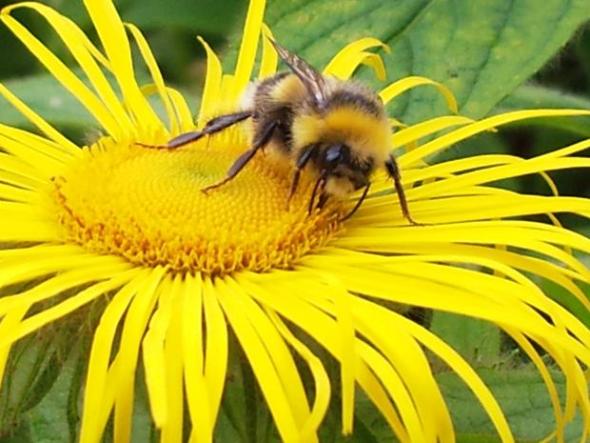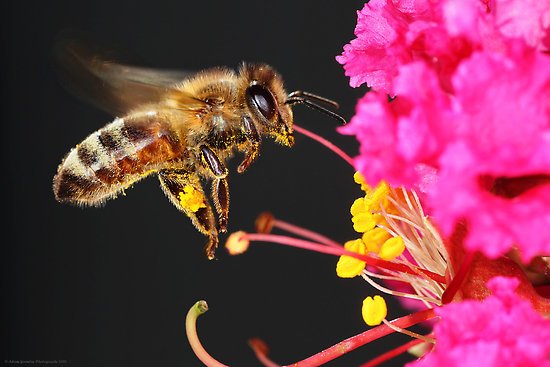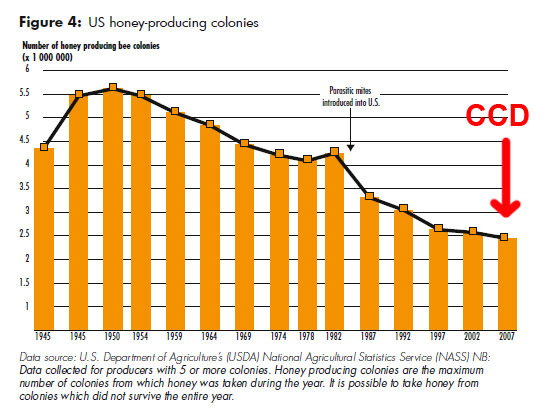Environmentalism chapter 6 - Bee Decline - An Environmental Nightmare

What’s happening to our bees? Since 1990 the population of bees has declined dramatically to date for 2013 the population of European and American honey bees has now declined by 50% which is extremely concerning for many agriculturists, horticulturists, environmentalists, but most importantly our natural wildlife that depend on such insects to pollinate some millions of flowering nectar plants that then continue the growing process of wildflowers, trees, maize, corn, to critically endangered species of flowering plants such Alliaceae Agardh endangered in Czech Republic, to the Colchicum autumnale one of the most endangered species of Crocus bulbs in the world.
There are no theories or stories regarding the decline of the honey bee, and the fact stands at this with evidential proof that the honey bee is now moving up to becoming a “vulnerable” species of insect that should we lose then we will be viewing some catastrophic agricultural and economical loss and failure that will have a knock on effect within the hypermarkets from grains, barley’s to cereal crops and even florists and more.
History of the Bee - Apis mellifera
Firstly before I give a brief history on the common European/Western American Apis mellifera please remember that the Apis genus has no relation to “manmade” (agricultural-botanical) deterrent “species” called Encarsia Formosa which is the wasp. Although the other species’s of Encarsia are natural the parasitic friendly Formosa breed in labrotories for pest control is nethier related to both wasp nor bee. This glass house agricultural friend is “a genetically grown and adapted pest controller”
The common wasp is named as this specimen however the deterrent that is used like the lady bird that is of no harm to humans at all, is specifically used for inside crop and glass house control of Aphids from black fly, green fly, red fly, and other succulent pests that wreak havoc in the botanical world.
There was a recorded 20,000 species of known bees that spanned the entire globe apart from the much colder climates which have many different behavioural patterns. There are now an estimated 18,000 species of bee from exactly nine “generic” families of which the honey bee makes up one of them the mellifera family.

The larger family of bee colonies is Apoidea, bees are known in the conservation world as arthropods, an amazingly complex species of “multi” family animals on our planet to date. An arthropod is invertebrate animal having an exoskeleton a segmented body, and jointed appendages.
Arthropods are members of the phylum Arthropoda (from Greek ἄρθρον árthron, “joint”, and ποδός podós “leg”, which together mean “jointed leg”), and include the insects, arachnids, and crustaceans. Arthropods are characterized by their jointed limbs and cuticles, which are mainly made of α-chitin
Bees are closely related to the wasp, ant, and cockroach. It’s truly impossible to determine the actual number of bee’s on the planet as they are almost microscopic and live in their “billions” which may sound “a vast quantity” however it’s not and the noticeable effects of decreasing numbers have been recorded as explained clearly below;
Destruction of the bee and bee colonies
- Colony collapse disorder (CCD) phenomena of which the worker bee the most important of them all just vanishes leaving the queen bee to die within the hive.
- Intensive farming methods that use more pesticides “although this was primarily dismissed” what some conservationists forgot to understand that pesticides are also sprayed with insecticides and fungicides, and new chemical fertilisers that are more potent today than they were back in 1070’s.
- Air and noise pollution.
- Habitat destruction that see the bee’s natural source of botanical nectar plant life destroyed to make way for buildings, and other construction activities.
- Nosemosis - Nosemosis is a parasitic disease affecting adult bees, due to the evolution and proliferation of the specific protozoan Nosema apis in the midgut epithelial cells. It causes digestive disorders (diarrhoea or constipation) and may impair the ability to fly bees have been hit hard by this parasitic disease that wipes thousands of bee’s out
- Fipronil - a broad spectrum insecticide that disrupts the bee’s central nervous system by blocking the passage of chloride ions through the GABA receptor and glutamate-gated chloride (GluCl) channels, components of the central nervous system. This causes hyperexcitation of contaminated insects’ nerves and muscles. Specificity of fipronil on insects may come from a better efficacy on GABA receptor, but also because GluCl channels do not exist in mammals. Fipronil is widely banned now in many countries as of dangers being caused to human health to.
- Carbon emissions.
- Seasonal weather disruption
- Excessive agriculture.
These nine points are what have amounted to such a vast decline in the number of bee populations falling worldwide and it’s now worrying many agriculturists, botanists and environmentalists as many plants require “insect” pollination and with the bee being one the best pollinators due to its furred body and size and location then seeing natures friend banished will have disastrous and detrimental effects on the planets ecological system that in turn will then have “knock on effects” to other species both plant, insect, avian reptilian and mammal.
From the beginning of the seventies to mid-2005-07 there was a vast decline in the number of honey bees then recorded that then had a knock on effect on the farming industry thus increasing cereal and crop prices. What was also evident to was the now almost banished bee from bee keeping within man controlled colonies of which there are few honey bee populations left in in most parts of the sates.
 2007 saw the population of Honey bee decline in the United States and Europe
2007 saw the population of Honey bee decline in the United States and Europe
Urbanisation and the Varroa mite a genus of parasitic mites associated with honey bees that have infected many thousands have been partly blame to the decline, sadly the Varroa mite is also a major reason why the domestic bee hive population has decreased rapidly too.
In 2010 after a recent study looked at many thousands of deceased bees within hives, a parasite named as Nosemosis was located, this parasite coupled with urbanization, pollution, insecticides, pesticides, fungicides and herbicides with massive over usage of glyphosate has been a contributing factor to the loss of the bee on an international scale never seen before.

Pic off the Varroa or Nosema mite that’s been killing thousands of bee’s of within hives to date
The parasite Nosema apis AKA Varroa and a IIV6 a Deoxyribonucleic acid virus is better explained below in formation.
Deoxyribonucleic acid virus & Nosema apis control
RNA viruses in insects are targets of an RNA interference (RNAi)-based antiviral immune response, in which viral replication intermediates or viral dsRNA genomes are processed by Dicer-2 (Dcr-2) into viral small interfering RNAs (vsiRNAs).
Whether dsDNA virus infections are controlled by the RNAi pathway remains to be determined. Here, we analyzed the role of RNAi in DNA virus infection using Drosophila melanogaster infected with Invertebrate iridescent virus 6 (IIV-6) as a model.
We show that Dcr-2 and Argonaute-2 mutant flies are more sensitive to virus infection, suggesting that vsiRNAs contribute to the control of DNA virus infection. Indeed, small RNA sequencing of IIV-6-infected WT and RNAi mutant flies identified abundant vsiRNAs that were produced in a Dcr-2-dependent manner.

Graph above indicates VIRUS CONTROL that’s aimed at “controlling Nosemosis” a type Encarsia Formosa parasitic wasp was used within scientific studies as they are closely related to the bee.
We observed a highly uneven distribution with strong clustering of vsiRNAs to small defined regions (hotspots) and modest coverage at other regions (cold spots). vsiRNAs mapped in similar proportions to both strands of the viral genome, suggesting that long dsRNA derived from convergent overlapping transcripts serves as a substrate for Dcr-2.
In agreement, strand-specific RT-PCR and Northern blot analyses indicated that antisense transcripts are produced during infection. Moreover, we show that vsiRNAs are functional in silencing reporter constructs carrying fragments of the IIV-6 genome. Together, data indicates that RNAi provides antiviral defence against dsDNA viruses in mammals. Thus, RNAi is the predominant antiviral defense mechanism in insects that provides protection against all major classes of viruses.
Please note “Thus, RNAi is the predominant antiviral defence mechanism in insects that provides protection against all major classes of viruses in insects and animals ” So in reality one would believe that the bee’s numbers would increase, however we simply don’t know if this is true even with scientific analysis we still cannot establish the actual cause nor “starting indicator” for Colony collapse disorder (CCD) to the infection of Nosemosis within the colonies.
However we have managed after taking ten hives apart in the late Autumn early and Winter of 2011-12 and then examining them along with deceased bees that Nosemosis although not yet “fully understood” has been surveyed in many hives which if the defense DNA virus did work and was successful then putting that to instant practice would help to save bee populations dramatically.
Regrettably with their being little known within this “area” of hive contamination and CDC phenomena then it’s difficult to establish if this is the actual main cause or just a “generic” infestation that is “contributing” along with all nine points to the destruction of the bee and colony factories as listed above.
International Animal Rescue Foundation Botanist Dr J Williamson ND, PhD, MEnvSc and Chief Executive Officer Dr J C Dimetri V.M.D, B.E.S, Ma, PhD, MEnvSc are working extensively on this subject along with international environmentalists and botanists to apiarists to conclude studies of which the nearing conclusive reports shall be sent to the Royal Horticultural Society, arboriculture scientists and botanists and universities in America with regards to this in-depth field study and whether extensive furthering field analysis should be resumed or whether they themselves have any furthering data to helping to preserve the bee and cease copiously dropping numbers.
Quote –
“Colony collapse disorder is significant economically as vast agricultural crops internationally are pollinated by bees and ecologically, due the major important role that bees play in the reproduction of plant communities in the wild through insect pollination with the bee being the world’s largest pollinator ”…. “Should no sufficient and conclusive study be located to cease this phenomenon then our bees will eventually vanish causing massive agricultural failure and rising cereal and crop prices thus forcing nations to import = more carbon emissions, and use of alternative (genetically modified crops and insects) = total Mother Nature destruction from manmade interference and lack of scientific understanding of arable and melittology and entomology species”..
— J C Dimerti International Animal Rescue Foundation
To think that one single species of insect that is 1.2 cm in length “could” cause such catastrophic economical failure is mind-boggling but extremely worrying economically and environmentally.

Dr J C Dimetri V.M.D, B.E.S, Ma, PhD , MEnvSc International Animal Rescue Foundation
The video above from Dr Elizabeth Ele, is “moving away from the problem” and this really is wrong education and sloppy science. Native bees that now America doesn’t have would of been able to sustain the crops of the almond and fruit trees that Dr Ele was describing. By simply keeping them in a hive and then “transporting them” to outer town agricultural districts may sound all good however if the bees have “infections” then they are or could contaminate other insects to plants life to. This is NOT how Mother Nature works and it’s also BAD management and science. To describe this is just the same as “artificial insemination” more or less as Americas “native bees” have practically vanished. So to see this is very concerning, however the Doctor seems more concerned with regards to the “crop and pollination factor” not “why” the native bees are in reality drastically reduced and how we should bring them back. - Poor management and BAD science.



